In this piece first published in The Conversation, Roy Maconachie discusses labour condition in DRC's mining sector.
It was a cool, dusty morning in July 2021, when I first visited the Kamilombe cobalt mine in Lualaba Province in south-eastern Democratic Republic of Congo. Situated just outside Kapata on the south-west outskirts of Kolwezi, a mining town that has historically served as an important centre for copper and cobalt, Kamilombe is now one of hundreds of spontaneously emerging cobalt mining sites in the region, where an enormous workforce of artisanal miners, called “creuseurs”, extract and process cobalt ore using rudimentary hand tools.
Estimates suggest that as many as 11,000 men and women work on the site, the majority of whom have no other means of deriving a livelihood.
Risking their lives, they tunnel deep into the red earth, excavating cobalt in shafts that descend as deep as 100 metres, and yet they receive almost none of the profits. Instead, they endure perilous working conditions, human rights abuses, and are paid poverty wages by agents and buyers who source small amounts from each miner at so called “buying houses”.
This story of labour exploitation and unequal exchange in Africa has become an all-too-familiar one to me. For the last 20 years, I’ve dedicated my academic career to researching the social, political and economic aspects of natural resources extracted or grown in sub-Saharan Africa.
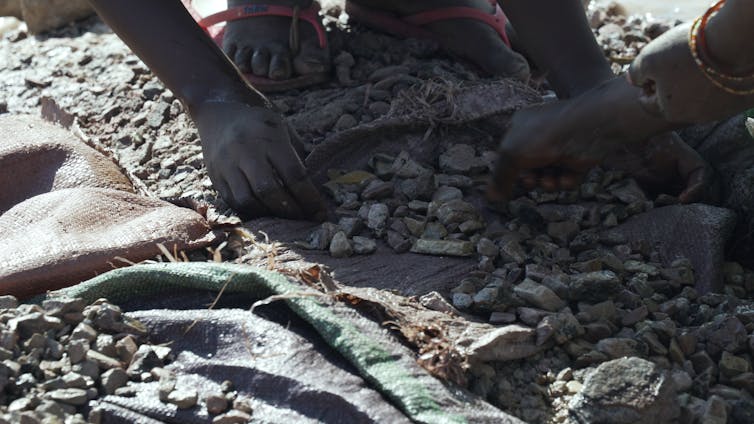
My first visit to the Kamilombe cobalt mine had a dramatic impact on me. I was eager to visit the site because I had heard many encouraging things about it. Since 2004, Kamilombe has been run by a mining cooperative called la Coopérative Minière pour le Développement Social (CMDS), which has partnered with the Fair Cobalt Alliance to try and improve artisanal miners’ safety and wellbeing.
Although it is well known that artisanal mining is now a vital rural livelihood in developing countries around the world, with World Bank estimates suggesting that there may now be as many as 100 million artisanal miners globally, a major concern has focused on its informal nature. Most artisanal mining sites are found in remote locations, remain unplanned and unregulated, and are subject to a host of social and environmental problems.
But at the same time, there has been much fanfare around the idea of organising artisanal miners into cooperatives, as a potential solution to this problem. By organising miners into groups and giving them a stronger collective voice, many argue that this could provide the necessary space for them to challenge their exploitation, including low pay, poor and unsafe working conditions, and human rights abuses. I was eager to find out if the situation at Kamilombe was any different, or if it would just be business as usual.
As we sat on a pile of sacks of cobalt ore in the early morning sun, Ghlislain Mujinga Kaungu, a 28-year cobalt miner and father of five, told me how the rising global demand for cobalt had transformed both the landscape and communities in the region. As we peered into the depths of Ghlislain’s mining pit he explained:
There are people who come from Kasai, the Chinese who leave China to come here, Canadians who leave their country to come here. All these people come to get the minerals. The ore is very good. It is very good.
Five months after my first visit, during the rainy season in December 2021, I returned to the Kamilombe mine to spend more time with the creuseurs, understand more about their difficult predicament, and this time, to produce a short documentary film on their lives.
The creuseurs that I met on site at Kamilombe, and the stories they shared, haunted me. They told me about the severe environmental damage and social harm caused by the rapidly growing extraction of cobalt, and the unequal terms of trade that cut them off completely from the wealth being generated.
Most of the miners I spoke to were well aware that they were being exploited. Many told me they only started mining because they wanted to create a better life for their kids. It is easy to understand why a parent would tolerate hardship, injustice and risk, if it could help their children.
Listening to their stories, it became immediately apparent that most miners endured such horrific working conditions because there were no other options in an employment-constrained economy. Mama Kalonda Alphonsine, a mother of eight and an ore washer at the Kamilombe mine, explained:
The work we do is hard because it’s a job you do all day long. And you have to bend all the time. We only do this work because we don’t have the means to survive.
Likewise, according to Ghlislain: “I have to go down the pit to feed my family. I don’t even have 100 Congolese francs in my house. There is no flour or vegetables.”
Ghislain went on: “I don’t wish my children to be miners. Not even for a single day. Normally, if I get 100 francs from the Chinese, I’ll put it towards their schooling, so that they become respectable people. So I can be proud when people say, ‘this is Ghislain’s son or daughter’.”
Such sentiments were confirmed by Pitchou, a 40-year-old ore transporter and father of four who had dropped out of university to haul bags of cobalt from the mining pit to the washing site on his bicycle. Pitchou said:
My bike is important because it is what feeds us, me my wife and my children. But the wish I have for my children when they grow up is that they must go to school. Because the education they are going to get will help them in future … My children should never go to the mine, they should focus on school because school is the future …
Even with our much greater awareness of global supply chains and volumes written about fair trade and sustainability, neocolonial exploitation is as much a part of the fabric of mineral extraction in the DRC as it ever was. But economic exploitation is only part of the story.
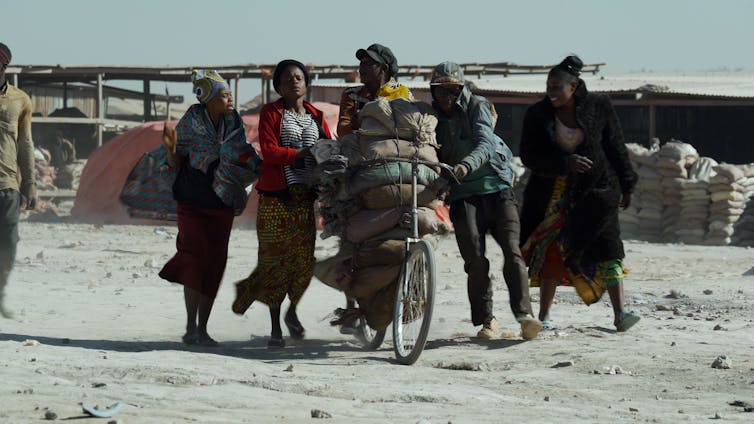
‘We miners die a lot’
While I was filming with cobalt miners during the rainy season, one of the mining pits collapsed. Six miners were killed and the depth and design of the tunnels meant that the bodies could not be recovered. Ghislain told me:
We have many cases of accidents during the rainy season. When it rains, a tarpaulin is put over the pit but if it rains heavily, the tarpaulin can tear. Water enters the pit, and anyone inside can drown.
And to be sure, all the miners I spoke to feared such a disaster could happen to them at any time. Such incidents occur on a regular basis and in January 2023, a similar cave-in at Kamilombe was reported by David Sturmes, the strategic partnerships director for the Fair Cobalt Alliance. He said: “A lack of mine planning and the resulting inability to manage water flooding into the mine after days of heavy rains caused individual tunnels to be blocked off, leaving no route to escape. The resulting pressure affected the structural integrity of the tunnel walls, causing cave-ins. Sadly, these kinds of incidents are not uncommon at most informal mines.”
For many creuseurs, part of the attraction of artisanal cobalt mining is the sector’s low “barriers to entry”. You don’t need advanced skills, a university degree, or large amounts of capital to invest. Anyone can become an artisanal miner.
However, there is also a downside to this. Compared to large-scale industrial mines, where there are significant capital investments in site preparation and development, artisanal mine sites are usually financed through their erratic cash flow.
More often than not, this leaves cooperatives unable to make much-needed investments in mine infrastructure. Death and injury is common among artisanal miners, due to both tunnel collapses and working without personal protective equipment. In the words of Ghislain:
Sometimes we are afraid because if you look at the ceiling (of the tunnel), you will see that it is already very fragile. The ceiling is already damaged. So, if we don’t make repairs, at some point when you’re down there, things are going to fall on you. And this can result in either a broken leg or a broken hand, or your skull will be fractured. Collapses are very frequent. We miners die a lot.
Toxic dust and birth defects
Further compounding the hazardous working conditions, cobalt dust is toxic, affecting all those working in mines, but also those in the wider community. People living near the mines display raised levels of cobalt in their urine and blood, and oxidative damage to DNA in children related to cobalt toxicity has been demonstrated.
That research also found high concentrations of uranium in the urine of exposed children and miners. Correlations have been found between levels of uranium in urine and drinking water.
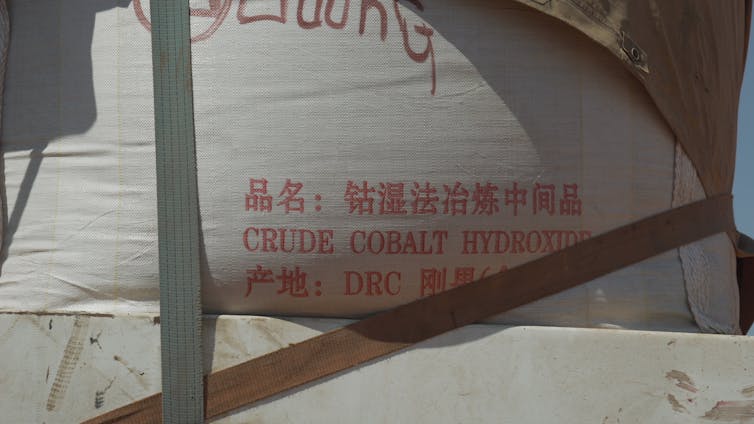
It is often the case that women wash the raw ore after it has been extracted, and pregnant women handling radioactive cobalt report stillbirths. A Lancet study found that pregnant women living in cobalt-mining communities have the highest levels ever reported of heavy metals in their blood. The same study demonstrated a five-fold increase in risk of birth defects in babies born to fathers working in cobalt mines.
Alphonsine, eloquently described the horrific conditions that washers must endure:
There are several problems in doing this work. First is the dirty water in which we are forced to work. Typhoid fever is common. We also often suffer from stomach pains and get infections, and as soon as we have a small fever, we get tested and find out it’s malaria. Women should not be washing these types of minerals, because they contain uranium. If uranium enters the body of a pregnant woman, it can cause a miscarriage or the baby to be malformed.
Another danger to the community are the sites themselves. Disused mining pits are often left abandoned like open sores on the landscape. Instead of being filled in and rehabilitated they fill with water, becoming breeding grounds for malaria-carrying mosquitos and a drowning hazard for local children.
No-one is held accountable. Recent comparisons of time-lapse satellite imagery over the past five years demonstrates the dramatic growth of cobalt mines in and around Kolwezi.
A recent story by ABC News noted: “The mines aren’t only growing around the city, they are often creeping into people’s neighbourhoods … satellite images of the west of the city reveal entire streets have disappeared over the last few years.”
The invisible face of the cobalt rush
Hunting for the buried blue treasure – a key ingredient in the lithium-ion batteries used in consumer electronics and electric vehicles that are vital to global efforts to combat climate change – artisanal miners like Ghislain have long been the invisible face of the cobalt rush. Until recently, their stories have been largely overlooked or ignored.However, all this seemed to change in recent years. A number of high-profile stories have shone a light on how skyrocketing demand for so-called “critical” minerals, such as cobalt, can wreak havoc on people and the environment at the bottom of the supply chain.
In his portrayal of the “dark side” of Congo’s cobalt rush in The New Yorker, journalist Nicolas Niarchos goes as far as to describe how, upon discovering that his house sat upon a rich seam of cobalt, one resident on the outskirts of Kolwezi tunnelled down 30ft through the floor of his kitchen to haul out ore at night.
The Congolese cobalt rush fuels a multi-billion-dollar industry for international mining companies and buying agents – often from China – that have moved into the country. Southern Congo sits upon 3.4 million tons of cobalt, an estimated two thirds of the world’s known supply.
Yet despite the frenzy of activity from foreign agents desperate to secure supplies of cobalt, many miners admitted that they were not entirely sure why there was so much interest in the mineral.
Alphonsine told me that she didn’t know what happened to the cobalt she washed, after it left the site. She said:
The cobalt will be sold abroad. We heard they sell it to China. How the product will be used in China is not known. We are only told that this product has several uses. But we don’t know what they are.
In 2021, Chinese companies produced 79% of the world’s electric vehicle lithium-ion batteries and have established a major presence in the DRC, creating new forms of corporate “colonialism”.
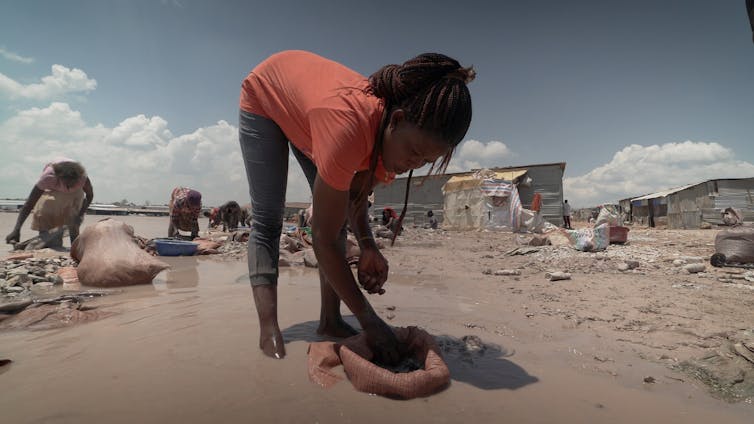
Ghislain told me that artisanal miners have very little bargaining power when it comes to negotiating with buying agents or securing a fair price for their cobalt. He explained:
You will see that to buy the ore, everyone has their price. Instead of buying well so that we too can win, they buy the products maliciously. When you bring the product to a buying house, they will force the price on you. And if you don’t agree, they will ask you to leave.
As the world transitions to electric vehicles, competition over supplies of cobalt continues to intensify, with global demand set to increase up to eight-fold by 2040. This, in turn, has ratcheted up geopolitical tensions and a new rivalry between the US and China, both of which seek to dominate the green energy revolution.
Against this backdrop, the OECD estimates that there are more than 200,000 creuseurs, often labouring alongside large-scale industrial operations, who extract up to 30% of Congo’s cobalt.
Child labour
Evidence from the charity Save the Children suggests that the majority of Congolese artisanal miners earn less than the DRC national minimum wage of $USD5 per day, and there is a significant gender pay gap, with women earning considerably less than men.
Moreover, some estimates indicate that there may be as many as 40,000 children engaged in artisanal cobalt mining in the country. Such claims have provided fertile ground for a high-profile legal case against the world’s largest tech companies, launched in December 2019 by Congolese families, over deaths and serious injuries sustained by child labourers in cobalt mines.
In October 2022, the US Department of Labour added lithium-ion batteries to its list of goods produced by child labour.
While it can certainly be argued that powerful multinational companies such as Apple, Google or Tesla should have the resources and technical capability to effectively monitor their supply chains and source their cobalt responsibly, traceability remains difficult. Numerous well-meaning transnational initiatives now exist to improve supply chain transparency, most of which align with OECD due diligence guidance.
No such thing as ‘clean cobalt’
At the same time, a significant challenge remains: there are a multitude of intermediaries in the mid and upper-tiers of the cobalt supply chain whose business strategies benefit from opaque practices. Profit margins are much higher when it’s possible to purchase cobalt that is extracted under slave-like conditions.
And the reality is that cobalt unearthed by creuseurs is bought by agents and processed alongside cobalt from large-scale mines, with over 80% of it then being refined in China. Under such circumstances, the supply chain cannot be fully regulated or monitored: it becomes cross-contaminated, and both sources of cobalt end up in electric vehicles and devices purchased around the world. As things stand, there is no such thing as “clean cobalt”. While many African countries are rich with highly sought-after resources, the wealth generated does not stay in Africa, or benefit its people. And there is, of course, a long history of this that extends back to colonial times. The current cobalt rush in and around Kolwezi appears to be no different.
During the colonial era, European imperial interests were channelled indirectly through small groups of local elites, who helped to govern territories and expedite the exploitation of resources for colonial agents. As African countries gained independence in the 1960s, one legacy of “indirect rule” was that it cultivated a ruling class of commercially-minded local elites who were unaccountable to their citizens.
This set the stage for the current second scramble for Africa, where the rampant expropriation of resources characteristic of colonial times has largely remained unaltered, apart from the arrival of new corporate agents of foreign exploitation that are extracting resources on an industrial scale.
The introduction of China and its Belt and Road Initiative as a major new player on the scene, has sparked considerable debate as to whether this offers a new opportunity for Africa, or a new form of colonialism.
Plausible deniability
While the negative impacts of the cobalt boom may be increasingly visible and have now become impossible to ignore, industry is not held accountable, partially because it has found new ways to hide its exploitative business practices.
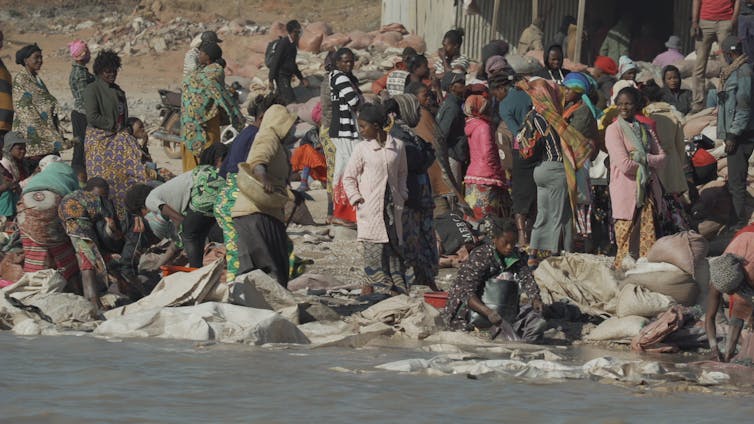
In the mining sector, intermediaries – buyers, agents, dealers and brokers – exist to shield multinational corporations from being directly implicated in labour exploitation. Complexity in the supply chain helps big corporations to demand profit-boosting efficiencies at arms’ length, giving them plausible deniability for the consequences of their actions.
These companies also have become adept at spinning their purported efforts to improve conditions. Look at their websites and you’ll probably see a massive section devoted to sustainability and community-building. On the surface, this may provide reassurance to a consumer or policymaker. But all those efforts don’t seem to be making a difference to those at the bottom of the chain, like Ghislain or Alphonsine or Pitchou.
We are all potentially complicit. I often tell my students that anyone with a mobile phone in their pocket probably has a little bit of the DRC in there as well. But multinational tech companies, or the mining giants have a lot more power and resources to make real change.
They should be made to pay for their role in creating and perpetuating unequitable systems that harm people and the planet. The people in the DRC’s cobalt belt that I have had the privilege of spending time with, and the many millions like them, deserve much better.
Respond